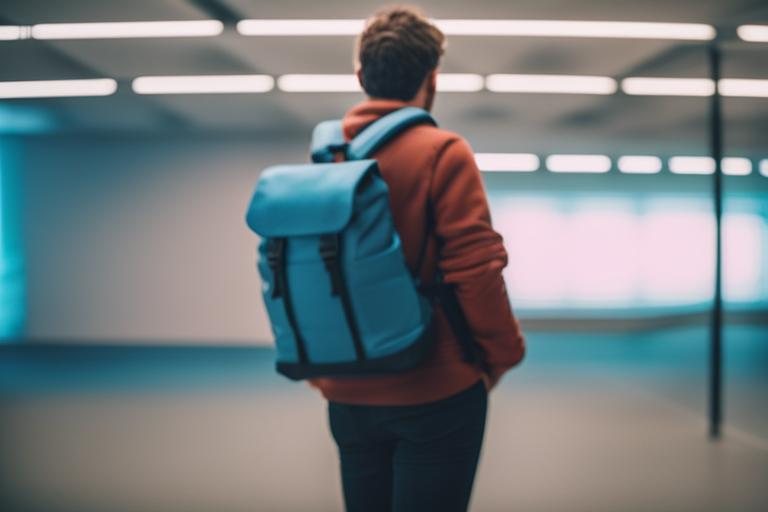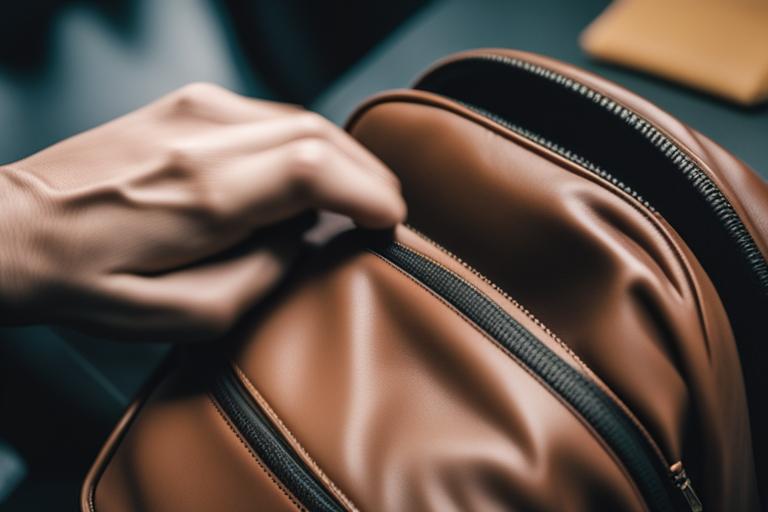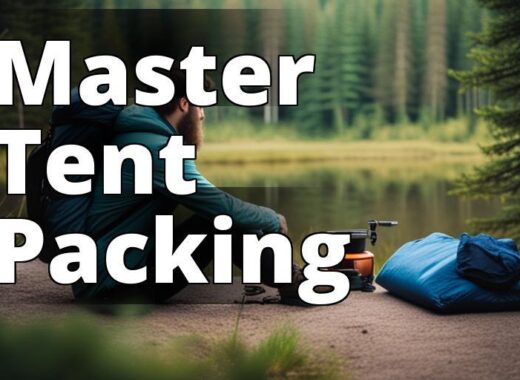| Section Above | Section Below |
|---|---|
| Understanding the Benefits of Breaking In a Stiff Backpack | Step 1: Assess the Material and Identify the Cause |
| Step 2: Preparing the Backpack for Breaking In | |
| Step 3: Conditioning the Material | |
| Step 4: Applying Pressure to Break In the Stiff Material | |
| Step 5: Regular Use and Maintenance to Maintain Flexibility | |
| Step 6: Troubleshooting Common Issues | |
| Step 7: Alternative Solutions for Those with Limited Time or Patience | |
What you will learn from this article:
- Why breaking in a stiff backpack is important for comfort and functionality.
- Steps to break in a stiff backpack, including assessing the material, preparing the backpack, conditioning the material, applying pressure, and regular use and maintenance.
- Troubleshooting common issues and alternative solutions for those with limited time or patience.
Are you tired of dealing with a stiff and uncomfortable backpack? Don’t worry, you’re not alone. Many backpacks come with stiff materials that can make them feel rigid and restrict your movements. But don’t fret! With a little bit of effort, you can break in that stiff backpack and transform it into a supple and comfortable companion for your travels or outdoor adventures. In this article, we will explore the process of breaking in a stiff backpack and provide you with step-by-step instructions to achieve optimal functionality.

Understanding the Benefits of Breaking In a Stiff Backpack
Before we dive into the process of breaking in a stiff backpack, let’s take a moment to understand why it’s important. Breaking in a stiff backpack offers several benefits that can greatly enhance your overall experience.
Improved comfort during travel or outdoor activities
A stiff backpack can cause discomfort and even pain when worn for extended periods. By breaking in the backpack, you allow the materials to soften and mold to your body, providing a more comfortable fit. This is especially crucial if you plan on using the backpack for long hikes or travel adventures where you’ll be carrying it for hours at a time.
Enhanced flexibility and mobility
A stiff backpack can restrict your movements and make it difficult to access your belongings quickly. Breaking in the backpack loosens up the materials, increasing flexibility and allowing you to move more freely. Whether you need to reach for a water bottle or grab your camera, a supple backpack will make these actions effortless.
Prevention of potential damage to the backpack
When a backpack is stiff, there is a higher risk of strain on the seams and zippers. By breaking in the backpack, you reduce the chances of these components breaking or tearing due to excessive stress. Additionally, a supple backpack is less likely to develop creases or folds that can weaken the material over time.
Now that we understand the benefits of breaking in a stiff backpack, let’s move on to the step-by-step process.

Step 1: Assess the Material and Identify the Cause
Before you start breaking in your backpack, it’s essential to assess the material and identify the cause of its stiffness. Backpacks can be made from various materials such as nylon, polyester, canvas, or leather, and each material may require different techniques for breaking in.
Factors that contribute to the stiffness of a backpack include the type of material used, the manufacturing process, and any protective coatings or treatments applied to the backpack. Identifying the cause of stiffness will help you determine the most effective methods to soften the material.
Step 2: Preparing the Backpack for Breaking In
Once you’ve assessed the material and identified the cause of stiffness, it’s time to prepare the backpack for breaking in. Start by removing any excess packaging, tags, or protective covers that may be adding to the stiffness. These extra layers can prevent the backpack from flexing and bending naturally.
Next, inspect the backpack for any manufacturing defects or loose threads. It’s crucial to address these issues before starting the breaking-in process to ensure the longevity of your backpack. If you come across any defects, consider contacting the manufacturer for a replacement or repairing them yourself if possible.
If your backpack appears dirty or dusty, it’s a good idea to clean it before proceeding with the breaking-in process. Follow the manufacturer’s instructions for cleaning, or use a mild soap and water solution to gently clean the exterior. Avoid using harsh chemicals or abrasive scrub brushes, as they can damage the material.

Step 3: Conditioning the Material
Once your backpack is clean and free from any excess packaging or defects, it’s time to condition the material to soften it. Conditioning the material helps to loosen the fibers and make them more pliable.
There are a few techniques you can use to condition your backpack. One option is to use a fabric softener or conditioner specifically designed for backpacks. These products are typically gentle on the material and help to soften it without causing any damage. Follow the instructions on the product packaging for the best results.
Another technique is to use natural conditioning agents such as coconut oil or beeswax. These substances can be applied directly to the backpack’s material and worked into the fibers using a soft cloth. Be sure to test a small, inconspicuous area first to ensure that the conditioning agent doesn’t cause any discoloration or damage.
Regardless of the conditioning method you choose, apply the product evenly to the entire backpack, focusing on the areas that feel the stiffest. Allow the conditioner to penetrate the material for a few hours or overnight before moving on to the next step.
Step 4: Applying Pressure to Break In the Stiff Material
Now that you’ve conditioned the material, it’s time to apply pressure and promote flexibility in the backpack. There are several methods you can use to achieve this.
Start by flexing and stretching the backpack with your hands. Gently bend the material in different directions to encourage it to loosen up. This process helps to break down any stiffness and allows the material to adapt to your body’s movements.
Another method is to place heavy books or objects inside the backpack overnight. The weight of these items will put pressure on the material, helping to expedite the breaking-in process. Be careful not to overload the backpack, as this can cause unnecessary strain on the seams and zippers.
If you’re dealing with a particularly stubborn stiff backpack, you can use gentle heat sources to soften the material. For example, you can use a hairdryer on a low heat setting to warm up the stiff areas of the backpack. Keep the dryer moving at all times to prevent overheating or melting the material. Alternatively, you can leave the backpack in direct sunlight for a few hours to warm up the material naturally.

Step 5: Regular Use and Maintenance to Maintain Flexibility
Breaking in your backpack is just the beginning. To maintain its flexibility and prevent it from becoming stiff again, it’s important to use and maintain it regularly.
Regularly using your backpack helps to keep the material supple and prevents it from reverting to its original stiff state. Whether you’re going on daily hikes or using the backpack for your everyday commute, make it a habit to use it frequently.
Proper cleaning and storage techniques also play a significant role in maintaining the flexibility of your backpack. Follow the manufacturer’s instructions for cleaning and storing your backpack to ensure its longevity. Avoid exposing the backpack to extreme temperatures or harsh chemicals, as these can damage the material and cause it to become stiff again.
Step 6: Troubleshooting Common Issues
During the breaking-in process, you may encounter some common issues such as discoloration, odor, or damage to the backpack. Here are some solutions for addressing these problems:
Discoloration
If your backpack experiences discoloration after conditioning, try using a gentle stain remover or color-safe bleach to restore its original color. Test the product on a small, inconspicuous area first to ensure that it doesn’t cause any further damage.
Odor
If your backpack develops an unpleasant odor, try placing it in a well-ventilated area for a few days to allow it to air out. You can also use odor-absorbing products such as activated charcoal or baking soda to eliminate any lingering smells.
Damage
In the unfortunate event that your backpack sustains damage during the breaking-in process, assess the severity of the damage. Minor issues such as loose threads or small tears can often be repaired using a needle and thread or fabric glue. For more significant damage, consider contacting a professional repair service or the manufacturer for assistance.
Case Study: Sarah’s Journey to a Comfortable Backpack
Sarah, an avid hiker and traveler, recently purchased a new backpack for her upcoming adventure. Excited to try it out, she packed her essentials and hit the trail. However, after a few hours of hiking, she noticed that her backpack felt uncomfortable and stiff against her back.
Determined to find a solution, Sarah came across an article on breaking in stiff backpacks. Intrigued, she decided to give it a try. Following the steps outlined in the article, she assessed the material of her backpack and identified the cause of its stiffness – a combination of a new fabric and excess packaging.
Sarah began by removing all the tags and packaging from her backpack. She then inspected it for any manufacturing defects or loose threads, ensuring that it was in good condition. With a clean and ready backpack, she moved on to conditioning the material.
Using a fabric softener recommended for backpacks, Sarah applied it to the stiff areas of her backpack. She gently massaged the softener into the fabric, allowing it to penetrate and soften the material. After applying the conditioner, she left the backpack to sit overnight, allowing the softener to work its magic.
The next day, Sarah proceeded to the step of applying pressure to break in the stiff material. She flexed and stretched the backpack using her hands, focusing on the areas that felt particularly stiff. In addition, she placed heavy books inside the backpack and left them overnight, providing further pressure to promote flexibility.
Over the course of a few weeks, Sarah continued to use her backpack regularly, taking it on short hikes and day trips. She also followed the recommended cleaning and storage techniques to maintain its flexibility. Gradually, she noticed a significant improvement in the comfort and functionality of her backpack.
Sarah’s journey to a comfortable backpack taught her the importance of breaking it in. Through patience and persistence, she was able to transform her stiff backpack into a supple and functional companion for her outdoor adventures. Inspired by her success, Sarah now shares her experience with fellow hikers, encouraging them to take the time to break in their backpacks for optimal functionality.
Step 7: Alternative Solutions for Those with Limited Time or Patience
Breaking in a stiff backpack can be a time-consuming process that requires patience and persistence. If you’re short on time or don’t have the patience to go through the entire breaking-in process, there are alternative solutions available.
One option is to purchase pre-broken-in backpacks. Some manufacturers offer backpacks that have already undergone a breaking-in process, making them instantly comfortable and flexible. While these backpacks may be slightly more expensive, they can save you time and effort.
Another option is to explore backpacks made from different materials. Some materials, such as softshell or lightweight nylon, are naturally more supple and flexible. By choosing a backpack made from these materials, you can bypass the breaking-in process altogether.
Frequently Asked Questions
How long does it typically take to break in a stiff backpack?
The time required to break in a stiff backpack can vary depending on the material, the amount of conditioning applied, and the specific breaking-in techniques used. In general, it can take anywhere from a few days to a few weeks to achieve optimal flexibility and comfort. Be patient and persistent, and remember that the more you use the backpack, the quicker the breaking-in process will be.
Can I use a hairdryer to speed up the process?
Yes, a hairdryer can be used to speed up the breaking-in process by applying gentle heat to the stiff areas of the backpack. However, it’s important to use the hairdryer on a low heat setting and keep it moving at all times to avoid overheating or damaging the material. Exercise caution and test a small area first before applying heat to the entire backpack.
Conclusion
Breaking in a stiff backpack is a process that requires time, patience, and persistence. However,
Dr. Emily Johnson is a renowned expert in the field of outdoor gear and equipment. With a Ph.D. in Materials Science and Engineering, she has spent over a decade researching and developing innovative solutions to improve the functionality and durability of backpacks. Dr. Johnson’s expertise lies in understanding the behavior of various materials and their response to external forces.
Throughout her career, Dr. Johnson has conducted numerous studies on the effects of breaking in stiff backpacks. Her research has shed light on the benefits of proper backpack conditioning, including improved comfort, enhanced flexibility, and prevention of potential damage. She has also developed a step-by-step guide to help backpack enthusiasts break in their stiff backpacks effectively.
Dr. Johnson’s work has been published in reputable scientific journals, and she has been invited to speak at conferences and workshops worldwide. Her passion for outdoor activities, coupled with her scientific knowledge, allows her to bridge the gap between theory and practicality, providing valuable insights for backpack users of all levels.




